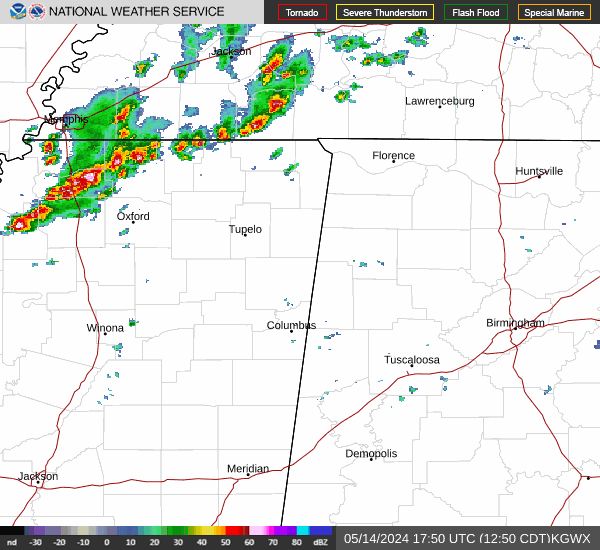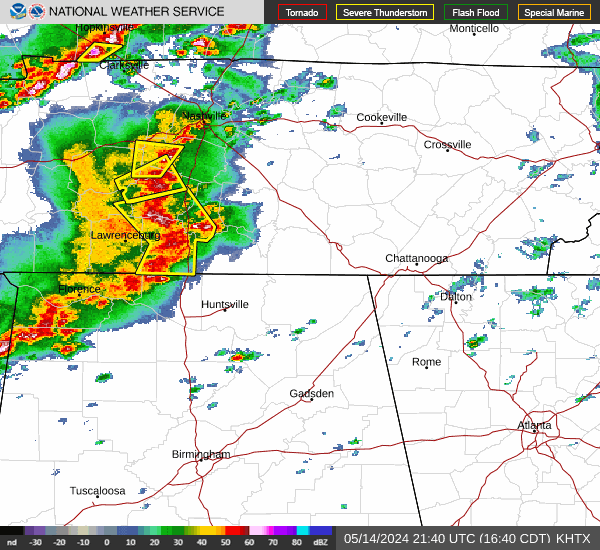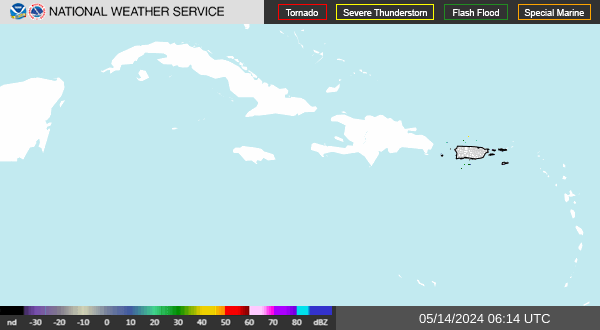FORECAST:
April Fools Day (High 80, Low 60): Mostly cloudy. Warm and breezy.
Tuesday (High 78, Low 66): Thunderstorms likely. A few storms may become severe.
Wednesday (High 60, Low 45): Mostly sunny. Breezy and turning much cooler.
EXTENDED OUTLOOK:
Thursday (High 59, Low 37): Sunny.
Friday (High 62, Low 33): Sunny.
Saturday (High 66, Low 35): Sunny.
Sunday (High 70, Low 38): Sunny.
PRONÓSTICO:
Lunes (Máxima 80, Mínima 60): Mayormente nublado. Cálido y ventoso.
Martes (Máxima 78, Mínima 66): Probabilidad de tormentas eléctricas. Algunas tormentas pueden volverse severas.
Miércoles (Máxima 60, Mínima 45): Mayormente soleado. Ventoso y volviéndose mucho más fresco.
PERSPECTIVA EXTENDIDA:
Jueves (Máxima 59, Mínima 37): Soleado.
Viernes (Máxima 62, Mínima 33): Soleado.
Sábado (Máxima 66, Mínima 35): Soleado.
Domingo (Máxima 70, Mínima 38): Soleado.
DISCUSSION:
Skies ranged from mostly sunny to mostly cloudy across the Tennessee Valley throughout the day today. I think it'd be fair to call it a partly cloudy day. It was definitely a breezy day as well, with wind gusts up to 20 miles per hour common, those winds generally being out of the South or Southwest. And it was a warm Easter this year. The High in Cullman was 77, and the Low was 52. By the way, that's the city I forecast for, even though I do try to pay attention to our neighbors in North Alabama and Southern Middle Tennessee. I hate it when the computer models get it right, and I was wrong by just one degree. I second guessed the general consensus of computer model data and forecast a High of 78 today. But 77 is close enough, eh? I agree with Tim Coleman, that you can beat the models, if you use your brain. But . . . sometimes the models still get it right instead. And hey, we do rely on them a lot.
Back to the observations, the High was 79 in Jasper today after a morning Low of 50. Somebody in my family used to say it stayed hotter down that way because that's where all the wicked people are. I'll leave that to local residents to judge one way or the other. And yeah, I'm having a sense of humor tonight, because I reached a point of exhaustion hearing people arguing over transgender rights and the sanctity of the Easter holiday. I started to offer my opinion on all that last night, but fortunately for all of us, thought better of it. There is too much to sort out in the world these days, and I can't save the whole thing. If it needs to be saved, I really will leave that to the Divine. Which I most assuredly am not. Very mortal, very flawed guy writing these weather discussions, you can count on that. But seriously, I hope everyone enjoyed the holiday to an extent, whether you made it to church, or got some chocolate eggs (or better yet, a whole chocolate bunny) or it was just another daily grind for you. Let's not forget, an awful lot of people don't get these holidays off work. Lest anyone from Jasper think I'm trashing on them, instead of just having a sense of humor about the things people say, they have an awesome radio station that I'm tuned in to right now, listening to Coyote J. Calhoun's Cemetery of Rock. It's not as great as his old show The Edge, because it doesn't include new music, but let me tell you, those old songs from the 1960's through the 90's sound better than you've ever heard them. And he is still the great DJ he's always been. So glad he is still around and still feels like sharing his great musical tastes with us. Even "Susie Q" by Credence sounds full of new life with these remasters he digs up. And I mention that station and show for a reason: A month or two ago, they suffered a bizarre theft, and are still raising money to replace their antenna and transmitter that was stolen. Once in a while, I like to offer them a helping hand in what way I can, which is just reminding people of the situation. And that they are a great station. I also want to salute Jay Fuller from Live 95.5 FM Cullman for openly supporting them both financially and in spirit. That's another great station, with the bonus that they do play new music. Though I can understand a station wanting to cut things off at about the year 2000 for rock music. You do have to sift through a lot of junk to find good rock music after roughly that time. But it does exist. And that's why I skip around stations and also use Pandora Radio.
If I don't quit yapping, we'll never get through the observations and on to the forecast discussion. So sue me, I had some hot cocoa tonight. I know it doesn't suit the weather now, but it is not as fattening as Coca Colas. And I did not eat any chocolate eggs today. So I got my fix from a cheap, harmless beverage that gives me a pleasant buzz, totally legal and just enough to lift my spirits for something like a weather forecast and an evening of wonderful music.
Haleyville had a High of 76 and Low of 57. Decatur had a High of 78 and a Low of 55.
By the way, for anyone who finds fault with my "free-form" method of giving the weather tonight, please remember that this is a volunteer effort. It is rare that anyone even donates a dollar or two to this lost cause. It is just something I still enjoy doing even though I dropped out of school a considerable long time ago. If I ever do get a real job in meteorology, I will observe a lot more professionalism. But for now, I'm really tired of being serious.
Huntsville had a High of 76 and a Low of 56 today. On the other side of the state, Muscle Shoals had a High of 77 and Low of 56. I used to work for a group called Shoals Weather based up that way, who didn't pay me, fired me on a totally bogus bunch of malarkey (I didn't even realize I was hired yet) which I suspect was really personal in nature, and they now call themselves "Tennessee Valley Weather", the name of my old website when I was in college for meteorology. They went so far as to also adopt the exact same screen name on Twitter and exact same web address I used to use. So yeah, I'm pretty sure it was personal. They claimed they had told me that they were a Facebook-Only-Operation, which they never had, and let me go because I wasn't doing Facebook for them, but doing stuff for their website and mine instead. I remember putting together some of their 7-Day-Planners. So maybe I'll get back into this some day. I would never work with any of those people again though, not the ones who were in charge back when I was briefly a part of it. I tried to stay in touch with Drew Richards, since it was Fred Gossage who "fired" me via a tacky e-mail. But he "ghosted" me from then on, before I had ever heard that term. Think he's working for Radar Omega now, which by the way, is a good product, regardless of who's working there. I still prefer Radarscope, better pricing and just more professional and solid in a lot of ways. Now those guys were awesome. I don't remember specific names, but when they were just Weather Decision Technologies, they let me embed their radar for years and years on my website, free of charge. It was an iMap sort of radar, not the later Radarscope format. They had a great weather radio app for smart phones too, but I don't now what ever happened with that. Nowadays I refer people to WeatherCall instead of that. Since it apparently no longer exists. Anyway, looking over to Tupelo, they had a High of 80 and a Low of 58. Memphis had a High of 76 and a Low of 62. They stayed mostly overcast throughout the day. And finally Nashville, home of all the lovable drunks, friends in low places, a place I wouldn't mind living, but more for the great music and culture than the freely-flowing alcohol (which Brad Paisley wrote a touching ode to one time), they had a High of 76 and a Low of 60. Clouds and humidity were a little more plentiful up Tennessee way and out to our Northwest today.
So we've got clouds moving in again as that high pressure system has slid off into the Atlantic, and now our next system is draped across a huge section of the country, but definitely through the Midwest, Upper Plains, and Ohio River Valley. They will likely be dealing with some severe weather tomorrow, could be somewhat organized.
Tomorrow should be fine for us, just clouding up a lot and staying breezy. High should be near 80, Low near 60. This is a get-ready day for our next system. Even at night, rain chances are just about nil.
Then on Tuesday that cold front comes in here, and we will have thunderstorms. Some could become severe, but notice the surface Low is way up in the Ohio Valley. So that may mitigate our severe weather threat. We do still have to watch it though. And more details on that below the main forecast discussion, will do a mesoscale discussion of the severe weather potential so I can give that full attention. This is, after all, the peak of our severe weather season. People actually debate now when the severe season should be around here, where they used to agree on it. People just love to fight over anything these days. But we all agree that April is the most dangerous month historically. In fact a lot of people forget that April 1, 1974 was a tornado event around here. Because April 3-4 was so much worse. But we actually had an April Fools Day tornado outbreak. It was no joke.
The ECMWF continues to show a slower timing than the GFS and NAM, which if it were to verify, would mean we'd see the storms come in during the evening, possibly lasting into the night hours, instead of getting started during the daylight hours. Of course we're on Daylight Saving Time now, so evening doesn't necessarily mean we're dark yet.
Going to forecast a High of 78 and Low of 65 for Tuesday. And remember, some of these storms may become severe. Even if you don't go down and read the details, just be aware that a few storms could be severe, and you do need to be prepared in case that happens, especially if you live in a mobile home and would need to get to a sturdier structure ahead of any severe storms.
We quickly become mostly sunny again on Wednesday, and we'll stay breezy behind the front. The airmass will modify quicky, a High near 60, Low near 45.
Thursday looks great, sunny skies, High near 60 again, some places might even have a hard time making it there and stay more like 58 or 59. The morning will be a bit colder with better radiational cooling overnight, the Low in the upper 30's. That's just how it is this time of year, temperature goes up and down a lot in a hurry.
Then high pressure in place again on Friday, so sunny skies again, really low humidity levels, and another cold morning. We'll get down into the lower 30's and likely see widespread frost Thursday night/Friday morning. If you want to get to freezing, probably head up to around Nashville, but even back here at the ranch, it may be a close call for some locations.
And then we warm up to the lower 60's for the afternoon High.
And the clear skies continue into the weekend. Saturday looks sunny with a High in the mid-60's, Low in the mid-30's. Again with these temperatures, have to look out for some frost. If you really want to be safe, you don't plant any sensitive crops around here until about the second week of April.
And we stay under the high pressure next Sunday, a week from today, with sunny skies and a High near 70, Low near 40 or at least in the upper 30's somewhere.
So overall it's pretty good news for this forecast, especially for April, just a few bumps in the road. Let's talk about the main one.
But first, just a quick note that most of us will only see an average of up to about a half-inch of rain for this forecast period. And Tuesday is the only day that rain is expected.
Unfortunately it is expected to come with some strong storms.
So let's talk about that.
MESOSCALE DISCUSSION:
As we get close to Tuesday's potential severe thunderstorm event, it looks like the SREF has a pretty good handle on it.
Dewpoints are expected to get up to at least 65 degrees across much of the area, so there's your instability, and wind shear between 0-6 kilometers is expected to be between 50-60 knots. This is at 4 PM CDT. So that's plenty of wind shear and sufficient instability to support some severe thunderstorms.
The surface CAPE is expected to be 1,000 joules or more, notice some values of 1,250 j/kg in Tennessee, so we'll be moderately unstable by that criteria. Another measure of the wind shear, the 3 km Helicity, is a little less than what we'd typically look for, for an organized tornado threat. Usually we'd want to see about 200 units here, and this is showing values in the 100's. So that is a clue that damaging thunderstorm winds may be a greater threat than any threat for tornadoes around here. So let's keep looking for more clues.
The Lifted Index goes down to about -5 though, which is some pretty strong instability. The theory behind that parameter is that you take a parcel of air at the surface, its temperature, and compare it to a parcel way up in the upper levels of the atmosphere.
Usually if you subtract the difference, you'll get a positive value, since air cools as it rises upward. However, the updrafts you see on a severe weather day are really warm air rising quickly. So if that value is negative, warmer air aloft than at the surface, then the air is unstable. And a value of -5 is definitely enough to start getting pretty concerned about. We have to take all these parameters into account together, but that one gets my attention.
Still the Helicity values at the lowest kilometer of the atmosphere are a little below what you'd typically expect from a tornado setup. So this continues to suggest more of a threat for straight-line damaging thunderstorm winds and some potential for large hail as well. For hail to be severe, it has to reach the size of a quarter, inch in diameter.
It is worth noting though, that the Significant Tornado Parameter (which is calculated with a specific equation, takes all factors into account) is expected to be between 1-2 over our region, the higher values more up around far North Alabama like Huntsville and into Southern Middle Tennessee. And notice there are isolated spots once you get up into Tennessee, closer to where that surface Low will be, where the value gets up to a 4, which suggests the potential for maybe a longer-tracked tornado, fairly significant tornado threat. A value of 1-2 usually points to an isolated tornado that, but once you get to 2 or above, you do have to start considering that the tornado threat may be more significant and organized. Again, you can't base a forecast on any one parameter. Have to take it all into account. But I would respect this severe weather threat we're about to deal with, regardless of where you live in the Tennessee River Valley.
The NAM looks concerning between 4-7 PM, a stout Energy Helicity Index. And if that slower timing of the ECMWF verifies, movement of the front and rain/storms, then that would dovetail nicely with this and with what the SREF is showing.
Sometimes the NAM makes things look worse than they really are, but still, taking a forecast sounding at 4 PM in Northwest Alabama (clicked on approximately Colbert/Franklin Counties since the EHI was maxed out there, at 2.7 I believe), it is showing CAPE over 2,000 joules, strong instability there, and Helicity values greater than 200 units, even strong turning of the winds at that lowest kilometer of the atmosphere. Supercell composite of 12 and Significant Tornado Parameter of 2-3. And that definitely points to a tornado threat.
It shows similar conditions around Double Springs at 7 PM Tuesday. The CAPE is "only" 1,600 units instead of over 2,000. But the Helicity values go over 300 units. So that balances out. Similar supercell composite and STP values. Somebody could get some tornado damage if this verifies.
Analog guidance remains unhelpful for this event. It suggests anything from just strong storms with almost no severe weather in the region to a widespread event with several reports of wind damage, large hail, even isolated tornadoes. Most of the analogs are toward the lower end of that spectrum though, not all that much in the way of severe weather around here.
Now to look at the official SPC outlooks, tomorrow and tomorrow night will not pose a threat for severe weather in North Alabama or Southern Middle Tennessee. We probably aren't even going to see any rain. But our neighbors from the Lower/Eastern Plains up through Missouri and into the Ohio Valley may see organized severe thunderstorms. Damaging winds, large hail, and isolated tornadoes are all possible over a broad area tomorrow. Not going to affect us, but it's good to get an idea of what it's doing out there. People travel. You might know somebody affected by tomorrow's weather. Notice that hatched area, mainly in Eastern Oklahoma, where unusually large hail up to two inches in diameter is possible.
Then on Tuesday, perhaps into Tuesday night, all of us in the Tennessee Valley are still under the basic 15% risk for severe thunderstorms. They will outline specific storm modes and those probabilities about 1 AM as we get into Monday morning, or maybe it's 2 AM. Daylight time confuses me sometimes. But anyway they'll get to that overnight, and most of us will see that during the day tomorrow. The only enhanced 30% risk area for now is mainly over Eastern Kentucky. But it does clip parts of Indiana, Ohio, and West Virginia. So again if you know people up that way or will be travelling, it's good to know details like that. A marginal threat for severe thunderstorms stretches all the way down to Mobile and Biloxi.
You need a reliable way to get alerts on Tuesday, ideally a NOAA Weather Radio with battery backup or a phone service like WeatherCall. At least enable wireless emergency alerts on your cell phone, even if you normally mute them, and if you can, stay tuned to a good source of weather information if this event gets going during the daylight hours, or if you are still up at night. But the great thing about the weather radio or WeatherCall is that it will reliably wake you up even if something does catch you while you're asleep. It is even more effective than a cell phone alert. That weather radio tone is almost impossible to sleep through.
The basic idea if you get a Severe Thunderstorm Warning or Tornado Warning is to get into a sturdy house, not a mobile home, or some sort of strong building that is properly anchored to the ground. If driving, you want to pull over to the nearest building, even if it's something very simple, like a gas station. Don't try to get up under a bridge. That myth was debunked many years ago.
In a sturdy house or other building, you need to:
* Stay away from windows.
* Get to the lowest floor.
* Try to be in a smaller room like a bathroom, closet, or hallway.
* Make that room as near the center of the building as possible.
* Cover your body from falling or flying debris, at least protect your head and/or neck.
And nine times out of ten, you'll be just fine even if a tornado hits you, with precautions like that. But you do have to get out a mobile home if a tornado is coming. Even lying in an unflooded ditch or culvert, or flat on the ground, is safer than staying in a trailer during a tornado. People have survived that way over the years, although of course, that is a last resort.
It is ideal if you have a storm shelter or can get to the underground part of a basement, but few of us have ideal options like that. Do the best you can within your means, and more than likely, it will be enough to protect you and your loved ones from serious injury.
And while we have to consider the worse scenarios for Tuesday, overall it just looks like a routine severe weather threat, mainly for damaging winds and large hail, with the tornado threat probably staying on the lower end. So what I've just said might overprepare you for whatever happens.
If we're really lucky, we might just get another high wind event without much actual severe thunderstorm damage. But I have a feeling at least some of our luck may run out this time, because the air looks like it will be significantly more unstable than it was able to get for the last several events that looked concerning. It's still not worth getting bent out of shape about, just the most common type of severe weather threat we've had many times in April over many decades around here. I'd just rather people err on the side of caution in case one or two places do get a fairly damaging storm. Even if it's just a tree falling on a house, or especially a car or trailer somebody is in, that's a big deal for whoever it happens to. We try to minimize injury and loss of life during severe weather events, and most of the time, that is easy to do. Those freak scenarios people love to play up, where there was nothing somebody could do, are very much the exception. As a rule, if you take basic precautions, you're very likely to survive a severe thunderstorm or a tornado without serious injury.
And besides Tuesday, the weather looks great. People with crops do need to be mindful of the frost potential later in the week, but no serious concerns other than that and Tuesday's severe thunderstorm chances.
I shared some salmon with Salem while writing up this spill. He doesn't like the weather turning warmer so far. He is the best cat I've had since I got out on my own as far as taking shelter from the weather though. I had to chase and fight the others. He will run to the closet, follow me, acting concerned. He is always overjoyed to get out of there though. He just has a lot of good sense and is a fine fellow.
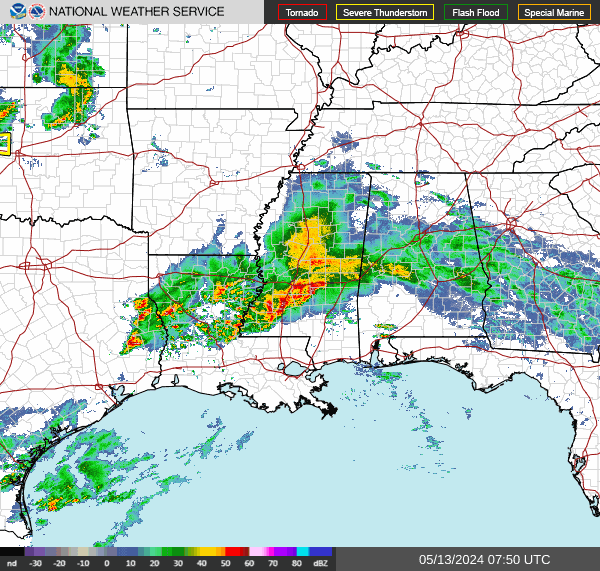
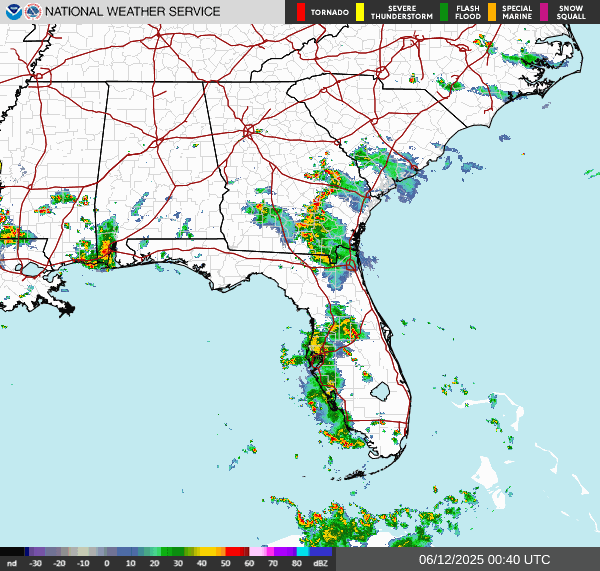








.webp)







































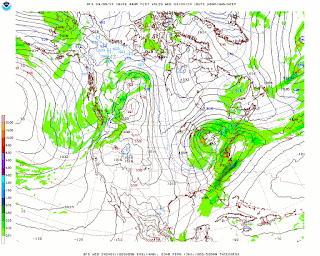
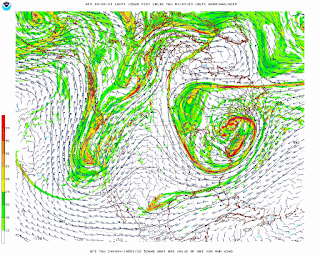














.png)








